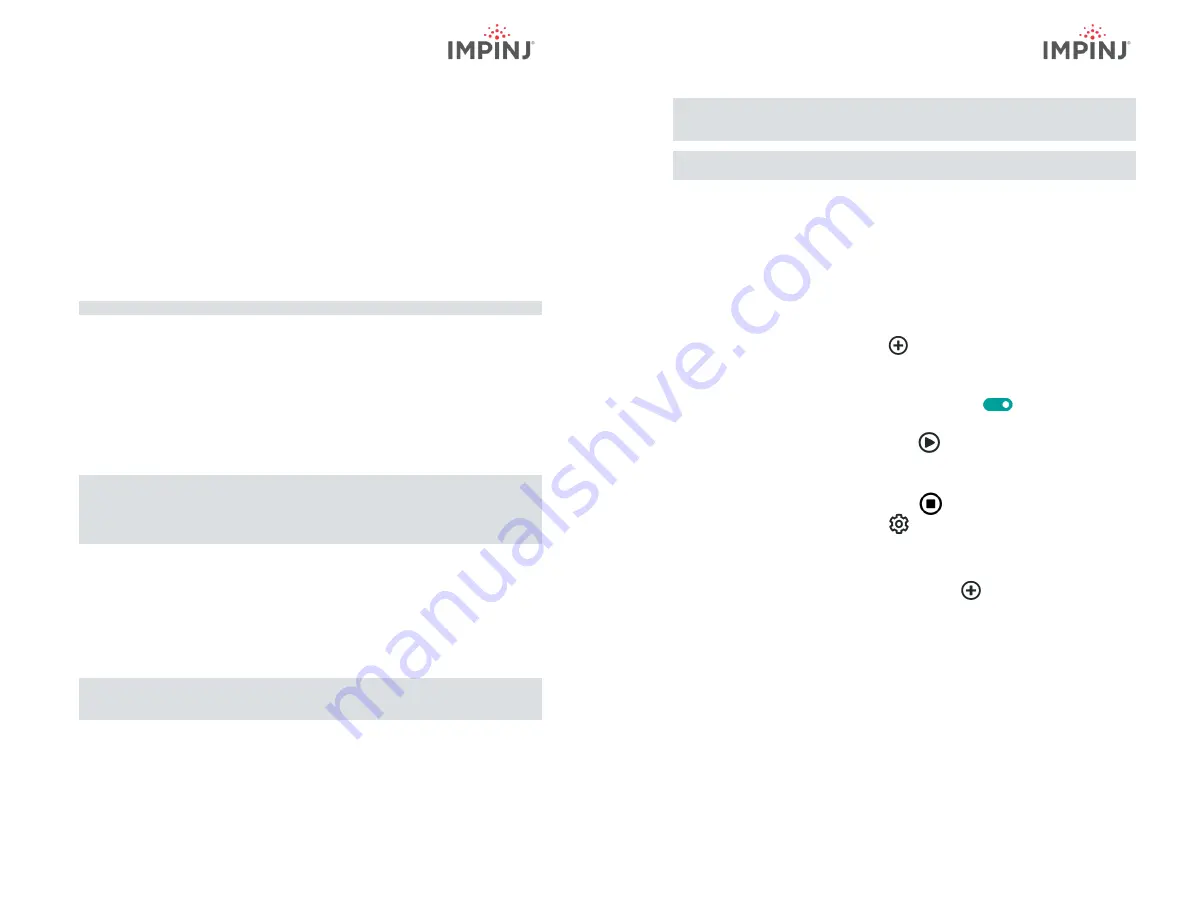
Document Version 3.0
© 2021, Impinj, Inc.
Document Version 3.0
© 2021, Impinj, Inc.
Remove and Install the Mounting Plate
The xSpan gateway has a detachable mounting plate to serve all applicable mount
configurations. It must be unfastened to access the gateway
’s ports and connectors
1.
Open the latch door and press to release the latch.
2.
Slide the rolling plate backwards. Rotate the plate upwards until you can pull out
the mounting plate and detach it from the xSpan unit.
3.
Install the mounting plate directly to a ceiling or wall, or to appropriate mounting
hardware. Hang the xSpan from the mounting plate but do not latch.
Powering the Gateway
The gateway can be powered in one of two ways: through the gateway
’s Power over
Ethernet (PoE / PoE+) capability, or with an AC power source.
NOTE:
Use either AC Power or PoE / PoE+. Do not use both simultaneously.
With PoE / PoE+
1.
Use the appropriate PoE/PoE+ Power Sourcing Equipment (PSE) and route an
Ethernet cable from the PSE to the xSpan’s Ethernet port.
•
R660-EU2 models: IEEE 802.3at certified (PoE+)
•
All other models: IEEE 802.3af certified (PoE)
With AC Power
1.
Connect an Impinj universal power supply to the +24VDC power supply port
NOTE:
This product is intended to be supplied with a Listed/Certified power
supply, marked LPS or Class 2, with 24Vdc output, rated minimum 2.1A.
(Ce produit est conçu pour être alimenté avec une alimentation Mis /
certifiés, marqué LPS ou de classe 2, avec sortie 24V, 2,1 A nominal
minimum)
xSpan Connectivity with DHCP Services
1.
Determine the xArray hostname to connect to a network with a DHCP server.
•
Hostname:
xSpan-XX-XX-XX (where XX-XX-XX is the last 3 hex couplets
of the reader MAC address, e.g. xSpan-12-AB-CD)
2.
If desired, test your connection by pinging <hostname>.local in the command
prompt (e.g., ping xarray-12-AB-CD.local).
NOTE:
If you are connecting your xSpan to a network with static IP addressing,
refer to the xSpan and xArray Installation and Operations Guide on the
Support Portal for instructions.
Updating the Firmware
1.
Connect to the web configuration page using a web browser at the URL
http
://
<
Hostname
or
Static IP
>.
2.
Log in using default credentials:
•
username:
root
•
password:
impinj
3.
Select your region from the drop-down list. (Optional)
NOTE:
The user is responsible for ensuring operation with the correct RF settings
and is solely responsible for any fines and other damages due to incorrect
or non-compliant country/region settings
NOTE:
GX1 and GX2 gateways have no region pre-configured and will not
transmit RAIN RFID signals until a region is selected.
4.
The gateway runs Impinj Octane firmware.
Make a note of the “Software Version”
shown on the web configuration page. If you are not running the latest version,
upgrade using the “Reader Upgrade” utility. (Download from the Support Portal
or ask your Impinj authorized partner for the latest released version.)
5.
Click the REBOOT button. When changing operating region, the change does
not take effect until the next reboot.
Using Impinj ItemTest Software
1.
Open the Impinj ItemTest software application.
2.
Add a new data source by clicking:
a.
Enter the reader hostname (xSpan-XX-XX-XX)
b.
Click Add Data Source
c.
Ensure the reader data source is enabled:
3.
Select the Inventory showcase (default). Place tags in the antenna field of view.
4.
Start tag inventory operation by clicking:
a.
Click a column header to sort by a specific attribute
b.
Right-click any column header to select which attributes are displayed
5.
Stop tag inventory operation by clicking:
a.
Click the Settings button to change how inventory runs are
configured
b.
Click Save to apply the updated configuration (Cancel to revert
changes)
6.
Click the reader name (under DATA SOURCES ) to change reader settings
a.
Update reader settings as desired
6.
Click Save to apply updated reader settings (Cancel to revert changes)


